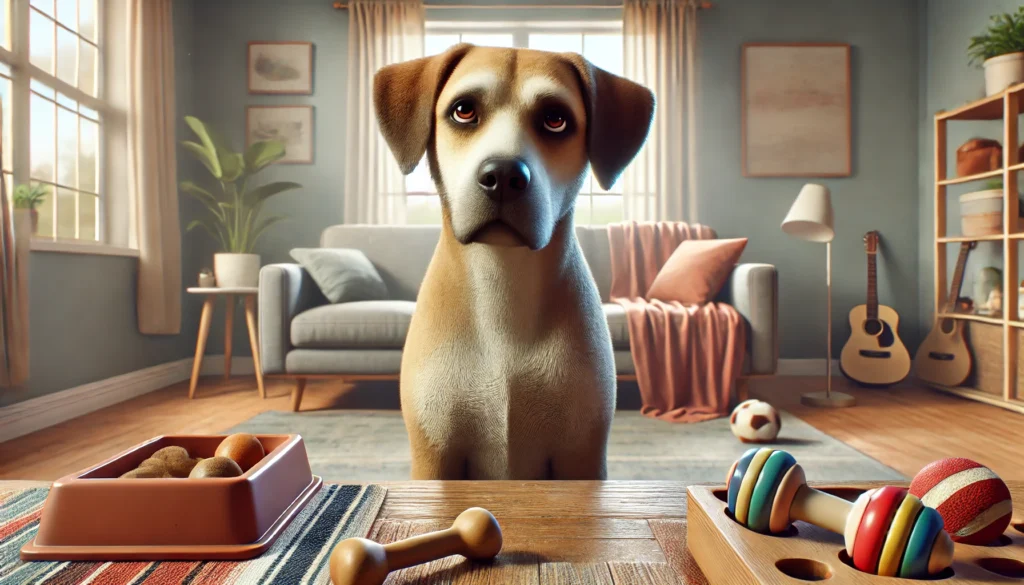Table of Contents
Section 1: Understanding Understimulation in Dogs
What is Understimulation?
Understimulation occurs when a dog lacks sufficient physical, mental, or social engagement, leading to boredom, frustration, and potential behavioral issues. Just like humans, dogs thrive on a combination of physical activity and mental challenges. When your dog is unstimulated for extended periods, its well-being suffers, manifesting as restlessness, destructive tendencies, or even signs of depression.
Dogs are naturally inquisitive and active creatures. Whether it’s sniffing out scents, solving problems, or engaging in play, they need enrichment to stay emotionally balanced. Understimulated dogs may compensate for this lack of engagement in ways that are often mistaken for “bad behavior.”
Why Does Understimulation Happen?
An unstimulated dog isn’t necessarily neglected—it’s often a case of mismatched expectations between owners and their pets. Here’s why many dogs end up unstimulated:
- Lack of Physical Exercise: Some breeds require intense physical activity to stay content, and a couple of short walks a day may not be enough.
- Minimal Mental Stimulation: Even physically active dogs need brain games, training sessions, and problem-solving tasks to
- Limited Social Interaction: Dogs are social animals; lack of interaction with other dogs or humans can leave them feeling isolated and unstimulated.
- Mismatched Energy Levels: High-energy dogs in low-activity households often end up severely understimulated, leading to pent-up energy and frustration.
How Understimulation Impacts Behavior
When a dog is understimulated, behavioral changes are inevitable. Here are some key signs that your dog may be struggling due to a lack of engagement:
- Destructive Chewing & Digging: Seeking an outlet for excess energy.
- Excessive Barking or Whining: A form of communication that often signals boredom or frustration.
- Hyperactivity (Zoomies, Restlessness): Sudden bursts of high-energy behavior can indicate an overstimulated nervous system from prolonged inactivity.
- Depression or Withdrawal: An unstimulated dog may become lethargic, uninterested in play, or less engaged with family members.
Section 2: Identifying Signs of Understimulation
Dogs communicate their needs through behavior, and recognizing the signs of understimulation is key to improving their quality of life. Below is a structured comparison of common symptoms and effective solutions:
| Signs of Understimulation | Solutions |
| Excessive sleeping (over 15 hours a day) | Engage in interactive play and daily training sessions. |
| Destructive behavior (chewing, digging, tearing furniture) | Provide chew toys, puzzle feeders, and interactive games. |
| Withdrawal or signs of depression | Increase outdoor time, social interactions, and enrichment activities. |
| Hyperactivity or frequent “zoomies” | Implement structured exercise routines like agility training or scent work. |
Expanding on These Signs:
- Excessive Sleeping: While adult dogs naturally sleep a lot, an unstimulated dog may resort to oversleeping due to a lack of excitement in their environment.
- Destructive Behavior: When dogs don’t get enough engagement, they create their own entertainment—often at the expense of household furniture.
- Withdrawal or Depression: An understimulated dog might lose enthusiasm for activities they once enjoyed, becoming disengaged and unresponsive.
- Hyperactivity & Zoomies: While zoomies are normal, frequent and intense bursts of hyperactivity can indicate that a dog isn’t getting enough physical or mental outlets.
Recognizing these signs early can help prevent stress-related behaviors and ensure your dog remains happy, healthy, and engaged.

Section 3: Solutions for an Understimulated Dog
Now that we’ve identified the signs, let’s explore how to stimulate your dog effectively:
1. Physical Stimulation: The Power of Movement
Physical exercise is one of the most obvious ways to keep a dog engaged, but simply walking around the block may not cut it. Instead, try:
- Breed-Specific Activities: High-energy breeds like Border Collies thrive on agility courses, while scent-driven breeds enjoy tracking exercises.
- Structured Playtime: Fetch, tug-of-war, and flirt poles offer high-energy engagement with added interactive benefits.
- Exploratory Walks: Vary your walking routes to introduce new scents and environments, providing mental stimulation as well.
- Obstacle Courses: Setting up mini agility courses at home can challenge your dog’s coordination and problem-solving skills.
2. Mental Stimulation: Engaging the Canine Mind
An unstimulated mind is just as problematic as an unstimulated body. Incorporate these activities:
- Puzzle Toys & Treat Dispensers: Encourage problem-solving and cognitive function.
- Obedience & Trick Training: Teaching new tricks keeps dogs engaged and sharpens their ability to learn.
- Scent Work & Nose Games: Dogs naturally enjoy sniffing and tracking, making scent-based activities incredibly rewarding.
- Interactive Feeding: Ditch the food bowl—hide food around the house or use slow-feeder puzzles to make mealtime engaging.
3. Social Stimulation: Building Canine Connections
Social engagement prevents loneliness and enhances a dog’s overall confidence. Consider:
- Playdates & Dog Parks: Social interaction with other dogs helps build communication skills and alleviates boredom.
- Group Training Sessions: Training in a group setting offers mental engagement alongside social enrichment.
- Regular Outings: Visiting dog-friendly cafes, trails, or markets introduces your dog to new experiences.
4. Environmental Enrichment: Creating an Engaging Home
A stimulating home environment can prevent boredom when you’re not around. Try:
- Toy Rotation: Dogs lose interest in the same toys over time, so rotate them to maintain novelty.
- New Scents & Textures: Introduce different surfaces (grass, sand, gravel) and scents (lavender, coconut) to engage curiosity.
- Interactive Smart Toys: High-tech toys can provide problem-solving challenges even when you’re away.
Here are Sections 4, 5, 6, Conclusion, and FAQs for “Signs Your Dog is Understimulated: Solutions”—crafted for maximum engagement and clarity.
Section 4: Weighing the Pros and Cons of Different Solutions
Every solution for an unstimulated dog comes with its own set of benefits and challenges. Below is an analysis of the most effective strategies:
1. Interactive Play
✅ Pros: Strengthens the human-dog bond, provides both mental and physical exercise.
❌ Cons: Requires consistent time and effort from the owner.

2. Puzzle Toys & Treat Dispensers
✅ Pros: Encourages problem-solving, prevents boredom during alone time.
❌ Cons: Some dogs need training to engage with puzzles, and novelty can wear off.
3. Structured Exercise Routines
✅ Pros: Helps regulate energy levels, improves overall health, and reduces destructive behavior.
❌ Cons: Needs to be adjusted to breed and age—too much or too little can cause problems.
4. Socialization & Group Training
✅ Pros: Enhances confidence, reduces anxiety, improves social behavior.
❌ Cons: Not all dogs enjoy group settings—some may require slow introductions.
5. Environmental Enrichment (Sensory Experiences & Toy Rotation)
✅ Pros: Provides daily novelty without requiring direct owner interaction.
❌ Cons: Needs periodic updates—dogs will lose interest if the environment remains unchanged.
This breakdown helps owners choose the best combination of solutions for their dog’s individual needs.
Section 5: The Bigger Picture—Why Stimulation Matters
Beyond improving behavior, proper mental and physical engagement has far-reaching benefits:
1. Social Benefits
A well-stimulated dog is more confident, less anxious, and more adaptable. Proper engagement prevents behavioral issues like excessive barking or aggression, making public outings smoother.
2. Economic Benefits
Dogs that receive adequate mental and physical stimulation are less prone to stress-related conditions like compulsive chewing, gastrointestinal issues, and anxiety-driven disorders—ultimately reducing vet bills.
3. Environmental Benefits
Exposing dogs to diverse environments—new parks, different walking trails, and varied terrains—helps them develop problem-solving skills, enhancing adaptability in unfamiliar situations.
Investing in a dog’s overall well-being creates a better quality of life for both the dog and the owner.
Section 6: Future Trends in Dog Stimulation
1. Ongoing Debates: Physical vs. Mental Stimulation
Some trainers argue that mental stimulation is just as (or even more) important than physical exercise, especially for working breeds. While physical activity burns energy, cognitive challenges keep dogs engaged longer.
2. Gaps in Research
- More studies are needed to determine breed-specific enrichment needs.
- Research on age-based mental stimulation is lacking—older dogs may benefit more from cognitive activities than physical exertion.
3. Emerging Trends: The Role of Technology
- Smart Toys & AI-Powered Enrichment: Devices that adjust engagement levels based on a dog’s responses.
- Dog-Computer Interaction: Studies suggest dogs can interact with touchscreens for mental stimulation.
- Wearable Tech for Dogs: Monitors activity levels and tailors enrichment suggestions.
Technology is shaping the future of pet enrichment, making it easier for owners to provide customized solutions for unstimulated dogs.
Conclusion
A stimulated dog is a happy dog. Understimulation can lead to boredom, frustration, and destructive behaviors—but with the right combination of physical, mental, and social enrichment, dogs can thrive.
Key Takeaways:
- Recognizing signs of understimulation early helps prevent long-term behavioral issues.
- Solutions should be tailored to a dog’s breed, age, and individual needs.
- A mix of physical, mental, and environmental engagement leads to a balanced, content pet.
By implementing these strategies, you can transform an unstimulated, restless dog into a happy, well-adjusted companion.
FAQs: Addressing Common Concerns
1. How do I know if my dog is truly understimulated or just lazy?
Lazy dogs still engage with their environment when encouraged. Understimulated dogs may display restlessness, destructive behavior, or withdrawal.
2. Can a dog be overstimulated?
Yes! Overstimulated dogs may become hyperactive, anxious, or struggle to settle down. Balance is key—too much activity without rest can lead to stress.
3. How much mental stimulation does my dog need daily?
This varies by breed, but at least 20-30 minutes of dedicated mental work (puzzle toys, training, scent work) is a great baseline.
4. Is daily physical exercise enough, or does my dog need mental games too?
Physical exercise alone isn’t enough. Dogs need mental challenges to prevent boredom—consider rotating activities to keep them engaged.
5. What’s the best way to stimulate a senior dog?
Older dogs may prefer gentler enrichment like scent games, food puzzles, and short training sessions to keep their minds sharp without overexertion.
6. My dog destroys every toy I buy—what should I do?
Invest in durable puzzle toys or use homemade enrichment (frozen treats, food-stuffed Kongs) to keep them engaged. Supervise until they learn to interact with toys properly.




